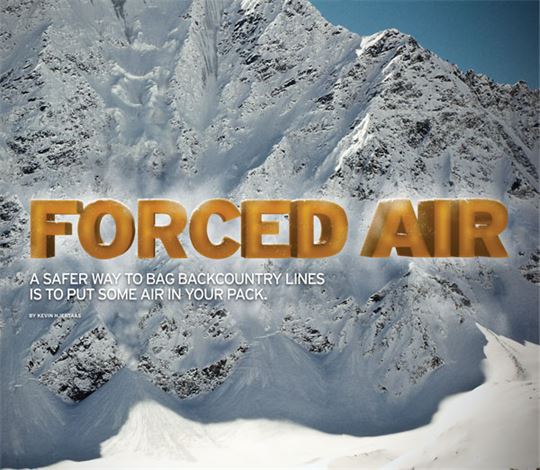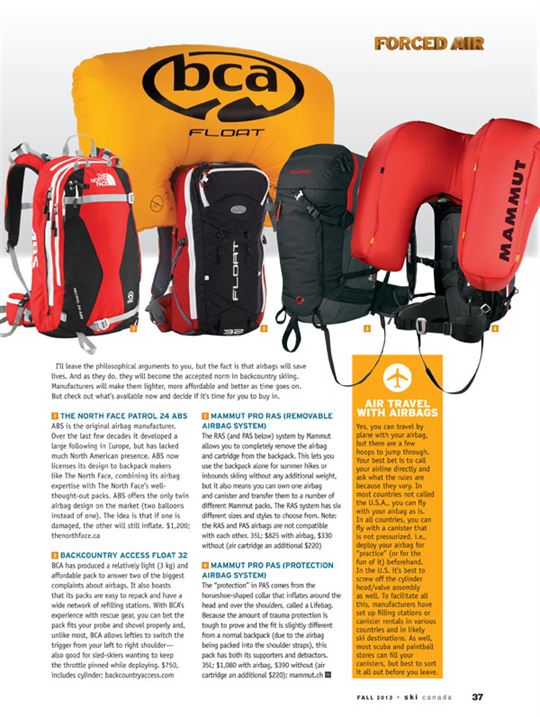Within two seconds I knew I couldn’t ski out of it.” What started as a small avalanche below Martin Lefebrve’s skis had propagated 20m above and all around him. It quickly took him off his feet and sent him downhill. In desperation he pulled the handle of his avalanche airbag. The pop and hiss told him it was inflating. “It was a beautiful sound!”
by Kevin Hjertaas in Fall 2013 issue

When the slide started to slow and lose momentum some 90m downslope, Martin assumed he was about to be buried. “I put one hand over my mouth [to create an air pocket] and stuck the other up in the air.” He believes that thanks to the airbag, he was never sucked under. Instead, debris buried him up to his chest, while the airbag on his back and his upper body remained on the surface.
So there you have one quick and dirty anecdote (and argument) for purchasing and wearing an avalanche airbag (or balloon bag). Airbags are designed to help keep you from being buried in an avalanche and in so doing they provide a “statistically significant increase in survival rates,” according to Pascal Haegli, The Avalanche Journal, 2012.
It’s called the Brazil Nut effect and, simply put, it means that larger particles tend to end up on top when things are shaken—like the bigger nuts in your bag of trail mix. The extra surface area of an inflated airbag makes you a bigger nut and more likely to end up on top of avalanche debris—after you are thoroughly shaken.
There are certain terrain traps or situations where an airbag will not keep a victim on the surface, but research suggests that more than 90 per cent of the time when a person pulls an airbag, they do not get buried. Not all of those people would have been buried without an airbag, though, and roughly a third of avalanche fatalities in Canada are the result of trauma, not asphyxiation. So they certainly do not guarantee you’ll survive a slide.
Some manufacturers have made dubious claims while marketing their bags, but most researchers feel there is still too small a data set to pin down accurate, real-world burial or survival rates. Bruce Tremper of the Utah Avalanche Center probably has the most realistic take: “My best guess is that avalanche airbag packs will probably save a little more than half of those who would otherwise have died in an avalanche.”
So why isn’t everyone wearing an airbag every time they hit the backcountry?
“Too expensive and heavy.” “Too unproven still.” “They give people an excuse to make bad decisions.” “They’re difficult to fly with.” “If I need one, I shouldn’t be skiing there.” These are the usual arguments for not using an airbag. They were once also the arguments for not buying avalanche transceivers.
There was a time when people would ski the backcountry with strings trailing behind. The idea was that if you were caught in an avalanche, some part of the string would be visible and your partners could follow it to find you. Simple and cheap, but it was not a reliable way to rescue people before they asphyxiated.
Beacons became the standard because they saved lives by helping rescuers quickly find a buried victim. Airbags take it one step further by preventing most burials in the first place.
I’ll leave the philosophical arguments to you, but the fact is that airbags will save lives. And as they do, they will become the accepted norm in backcountry skiing. Manufacturers will make them lighter, more affordable and better as time goes on.
But check out what’s available now and decide if it’s time for you to buy in.
1. The North Face Patrol 24 ABS
ABS is the original airbag manufacturer. Over the last few decades it developed a large following in Europe, but has lacked much North American presence. ABS now licenses its design to backpack makers like The North Face, combining its airbag expertise with The North Face’s well-thought-out packs. ABS offers the only twin airbag design on the market (two balloons instead of one). The idea is that if one is damaged, the other will still inflate. $1,200; thenorthface.ca
2. Backcountry Access Float 32
BCA has produced a relatively light (3 kg) and affordable pack to answer two of the biggest complaints about airbags. It also boasts that its packs are easy to repack and have a wide network of refilling stations. With BCA’s experience with rescue gear, you can bet the pack fits your probe and shovel properly and, unlike most, BCA allows lefties to switch the trigger from your left to right shoulder—also good for sled-skiers wanting to keep the throttle pinned while deploying. $750, includes cylinder; backcountryaccess.com
3. Mammut Pro RAS (Removable Airbag System)
The RAS (and PAS below) system by Mammut allows you to completely remove the airbag and cartridge from the backpack. This lets you use the backpack alone for summer hikes or inbounds skiing without any additional weight, but it also means you can own one airbag and canister and transfer them to a number of different Mammut packs. The RAS system has six different sizes and styles to choose from. Note: the RAS and PAS airbags are not compatible with each other. 35L; $825 with airbag, $330 without (air cartridge an additional $220)
4. Mammut Pro PAS (Protection Airbag System)
The “protection” in PAS comes from the horseshoe-shaped collar that inflates around the head and over the shoulders, called a Lifebag. Because the amount of trauma protection is tough to prove and the fit is slightly different from a normal backpack (due to the airbag being packed into the shoulder straps), this pack has both its supporters and detractors. 35L; $1,080 with airbag, $390 without (air cartridge an additional $220); mammut.ch
Air travel with airbags
Yes, you can travel by plane with your airbag, but there are a few hoops to jump through. Your best bet is to call your airline directly and ask what the rules are because they vary. In most countries not called the U.S.A., you can fly with your airbag as is. In all countries, you can fly with a canister that is not pressurized, i.e., deploy your airbag for “practice” (or for the fun of it) beforehand. In the U.S. it’s best to screw off the cylinder head/valve assembly as well. To facilitate all this, manufacturers have set up filling stations or canister rentals in various countries and in likely ski destinations. As well, most scuba and paintball stores can fill your canisters, but best to sort it all out before you leave.
